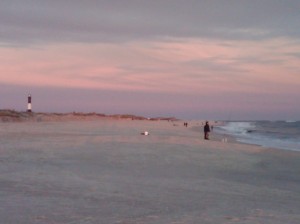Return From The Sargasso
November 11, 2010
It’s been nigh a year since my previous post…a year has come and gone, and with its passing, the seasons have run their cycle…as is the nature of such magical things that come, go, and are born again, The Good Herring may return.
Inspiration, move me brightly!
The idea to reinstate The Good Herring was born on a soft, warm breeze; an invigorating gust, blowing over a placid patch of algae-rich waters smack-dab in the middle of the Atlantic ocean, a place known to some as the Sargasso Sea, but more widely known as the Bermuda Triangle.
Despite the supernatural connotations implied by this notorious location, however, the wind carried with it no government conspiracy, nor did it bear tidings of close encounters of the third kind. It picked up speed, urged on by the simmering tides, gusting towards the North American landmass with a purpose. When the wind finally made landfall on the rocky shoals of Eastern Long Island, it summoned great waves capped with yellow sea-foam to crash upon the feet of a sturdy lighthouse.
It happened to be sunset; the sprays brought up by these surges of ocean were painted a burnished orange by the setting sun. Fisherfolk, casting for dinner from a sandy beach nearby pulled in their final catches of the day: a lucky man smiled at the 17 lb. striped bass caught on the end of the line, its scales mirroring the purple haze of dusk.
The night, of course, bore no hurdle to the inexorable path of that gale. Soon it completed its long journey, winding its way through the narrow, cobblestoned streets of Brooklyn to arrive at The Good Herrings’ very own shanty.
The back door blew open gently with a creak, shaking me out of my reverie. I just completed a great book; coincidentally, it was as myopically focused as the one that inspired the creation of this blog. This particular piece of literature was entitled Consider The Eel: A Natural and Gastronomic History.
The casual reader might think me a bit strange, so intrigued by these deep-dives into aquatic creatures that are, at least in America, so unpopular. Well, I don’t blame you. To be honest, it’s true these animals are widely not in favor and it’s equally true I happen to love eating them both. All that said however, these tomes are at once informative, intriguing and immensely enjoyable reads that can be savored by just about anyone with an interest in food and history.
Focusing on Consider The Eel for a moment, the long story short is that the Eel is a unique and mysterious creature to be sure. Unlike most of it’s other aquatic cousins (eg: the Salmon) that are born in fresh water rivers, spend their lives in the open ocean and then return to those same rivers to reproduce and die, the eel is born in the ocean, migrates to fresh water rivers where it lives for several decades and then finally returns to where it was born to reproduce and pass away. The crazy thing is: noone knows exactly where all these eels are born and die…but scientists have narrowed down the location to the Sargasso Sea, aka: The Bermuda Triangle.
It’s funny to think of an eel as your inspiration, but alas, sometimes an idea can come from the strangest of places. For example, it’s lunchtime now, and I think I know just what I’ll be having.
Stay tuned–the Good Herring is back in town!
The Marvel Of Perceptual Vigilance
October 23, 2009

Squelettes se disputant un hareng saur
BurgerBoy and BurgerGal, nestled together in the corner of some dark cafe somewhere in Paris, perhaps amidst a rising cloud of blue-tinted Gauloises smoke, sent a snapshot via email from across the pond this fine Friday morning.
Evocative of the classic Van Gogh painting ‘skull with cigarette’ (the most distinguished of his paintings from the Antwerp period), this painting here portrays two skeletons locked in mortal combat over–yes, you guessed-it–a herring!
It’s amazing that BurgerBoy noticed this element. Herring aren’t exactly on your average Joe’s radar, but it’s interesting how once a person becomes sensitized to something (eg: herring), their mind changes the way it filters impressions, and suddenly, that thing you’ve recently been made aware of seems to appear all the time in different places. Advertisers love this, of course.
Psychologists call this phenomenon ‘perceptual vigilance’, and it’s something we can all pretty much relate to. That said, I encourage readers to send in any picture or mention of a herring they find in their travels. I’d be happy to post them!
We salute your perceptual vigilance BurgerBoy. Vive le France!!!!!
Oyster Frenzy
September 30, 2009
At high noon this Saturday, October 3rd, The Oyster Bar at Grand Central is loosening the straight jacket on bivalves from around the country…it’s time for the annual Oyster Frenzy!
From Big Atlantics to Petit Pacifics, Sweet Kumamotos to Salty Cape Mays, this all day event will feature slurping and shucking contests, chef demos and a wide variety of beverages to fit the pairing preferences of just about anybody.
Grand Central Oyster Bar is a seafood destination restaurant located deep in the belly of Manhattan’s busiest transportation hub, Grand Central Terminal. The restaurant actually opened along with the terminal itself back in 1913, so it has quite a bit of historical cache. Aside from the quality seafood, one of the finer aspects of a dining experience at the GCOB is the ambiance.

The design highlight is certainly the beautiful vaulted, tiled ceilings which fit the Grand Central architectural scheme so well. If you visit, make a point of trying to score a seat at one of the old-school u-shaped bars with tiny white Jr. captain’s seats, or ideally, in the heat of the action at the oyster bar itself, where you can watch Carlos and his team of skilled shuckers give street cred behind the frenzy.
Lastly, I might add that the archway in front of the restaurant is also famous in it’s own right for an unusual acoustical quirk. Basically, someone standing in one corner can hear someone standing in the other corner perfectly well no matter how softly they speak.

Not sure if this fun little aspect of the GCOB experience is an accidental or intentional result of the arched design, but it certainly makes for a fun experiment after imbibing on oysters and champagne! No visit to the Oyster Bar would be complete without it.
For more information, to inquire about entering one of the contests, or to make reservations for the annual Oyster Frenzy email info@oysterbarny.com or log onto www.oysterbarny.com.
The Good Herring and his Herring Lass will certainly be there this Saturday to participate in the frenzy and fete the birthday of the world-famous DJ Probiotic.
A Saturday Night at Carnegie Hall
September 17, 2009

Phish frontman Trey Anastasio partnered with the New York Philharmonic Orchestra this past Saturday evening at Carnegie Hall for a beautiful rendition of his versatile new composition, Time Turns Elastic.
The black tie getups were in full effect with all due respect to the occasion at such a prestigious venue. After the orchestra tuned-up, Trey, carrying his electric guitar, approached the front of the stage with his signature beaming smile, and was greeted by the conductor, Asher Fisch. The music began.
The first ’set’ consisted of symphonic renditions of a variety of classic Phish chestnuts. The interpretations were surprisingly engaging and textured, the sound clear and crisp even from our position in the balcony level. They say no seat at Carnegie Hall is a bad one with respect to sound, and I’d have to agree. A highlight of the first set was surely the dynamic and genre-shifting take on ‘Guyute‘, with its rousing and triumphant crescendo, in Wagner-esque fashion.

Time Turns Elastic manifesting itself in orchestral format represents the culmination of a lifetime achievement for Trey; a single composition that’s been interpreted and expressed three separate ways: solo, by means of acoustic guitar, as an electric rock “opera” by Phish, and finally, in all its glory with full orchestral accompaniment at Carnegie Hall. A trifecta of that scale is quite an achievement for a performer by any standard, but it’s also a wonderful experience for a listener as well.
Back in the Springtime, Phish released a sparse acoustic treatment of Trey playing TTE at The Barn, their private studio outside of Burlington, VT. By early Summer, Phish teased it’s fanbase with a short video of a electric studio rehearsal of TTE promoting the itunes release of the song, the first new studio release from the band in over 5 years.

Days later, we found ourselves in the hallowed grounds of Boston’s Fenway Park for Phish’s first show of their 2009 Summer Tour. The live debut of TTE arrived midway during the second set but was hampered by deplorable acoustics (Fenway is the antithesis of Carnegie Hall from a sound perspective). Thankfully, we had the good fortune of hearing TTE live at several other shows over the course of the summer, the best version of which may have been served up a week after the Fenway show amidst the swirling evening rains at Jones Beach Amphitheatre on Long Island, NY in early June.
How fitting to complete the TTE trilogy at the hallowed Carnegie Hall while wearing a tuxedo, pockets full of complimentary Ricola.

Last but not least, Trey and the Philharmonic presented the orchestral debut of the Vermont quartet’s seminal tune: You Enjoy Myself, for the finale of the concert. Transcending the parameters of traditional classic music, this particular piece was infused with shuffling latin rhythms, syncopated staccato guitar licks and above all, humor. In typical Phish fashion, the translated composition of YEM from prog-rock epic to classical movement effectively leveraged the audience’s familiarity with the composition to its full advantage. Instead of heavily anticipated and beloved guitar chords, elephantine horns squealed out in whoopie-cushion fashion, timely deflations that incited peals of laughter from the audience and orchestra alike.
Personally, I’m still trying to figure out what impressed me most, Trey’s virtuosity on guitar or his stunning vocal chops. Not only did he nail virtually every single note of these composed pieces on acoustic and electric guitar, the guy also sang like a bird, his warm and familiar tones tastefully accented with warbling vibrato. Mind you, this is a man who is no stranger to playing in front of crowds of up to 80,000 roaring fans, but I have a feeling that standing in front of Carnegie Hall and singing your heart out without the cover of a backing band is somehow much more difficult. Phish band-mate Mike Gordon was once quoted giving Trey some constructive criticism after a show in Europe, saying, “I thought you were kind of going off a little…Well, I mean you just were playing a lot of notes”. Anyone familiar with Trey’s proclivity for musical exploration and virtuoso improvisation will likely relate to Mike’s feedback.
Although Mike, who is currently on tour with his own band, wasn’t in attendance, I’m sure he’d agree that Trey played just the right number of notes on Saturday night. At concert’s end, a standing ovation and the satiated smiles of performer and listener alike were testament to the success of the project.

Etymology and Mission Statement
September 16, 2009

In the 1997 edition of Facts on File Encyclopedia of Word and Phrase Origins, Robert Hendrickson traces the roots of the phrase “Red Herring” back to escaping criminals in the 17th century who would “drag strong-smelling red herring across a trail to make pursuing blood-hounds lose the scent”.
The raison d’etre of this blog, however, will not be to deter seekers from their prize. Instead, The Good Herring—a digital forum to share and expound upon my favorite food, travel, music, art and cultural experiences and observances—will aim to promote awareness of all manners of things I consider to be, in essence: good!
“OK, I get the premise, but what’s with the herring?” You might ask. Well, modern public perception of herring here in America is, in general, poor at best. I’d venture to bet the majority of my peers would turn their noses up at the prospect of eating one of these fine fish. Nobody put it better than the Kipperman himself, Mike Smylie, in his book, Herring: A History of the Silver Darlings, when he said (and I paraphrase), that herring are generally considered to be the smelly, bony, unpalatable and undesirable food of the poor, a fish of necessity, the epicurean pariah of the sea. The contradiction however, as his fine historical account explains in detail, lies in the fact that the socio-economic and cultural impact of these noble creatures on Western European and American history is palpable, and wholly positive.

As Europe emerged from the dark ages and northern populations began to soar, herring was realized to be a plentiful (albeit highly perishable) source of food. Once the means to curing and preserving these fish was discovered, the grand herring roll-out began in earnest. Fishermen subsequently learned how to catch them in droves with ever increasing skill. The booming industry employed droves of men and women. In fact, 1-in-4 Brits were employed in the herring industry in the early 1800’s. Herring helped sustain the poor and feed armies…it could easily be said that these tiny fish helped changed the face of European history.
All those compelling points aside, the bottom line people might be able to relate to best is that herring have a bum rap for not tasting good. In fact, that fallacy is a ‘red herring’ in every sense of the idiom: herring are not only delicious, you’d have to look hard for a fish offering better nutritional value!
We’ll be talking more about the benefits of herring, of course, but in the meantime, let it be said that I bid you welcome and invite you to feel good about following the accounts presented here at “The Good Herring”.



